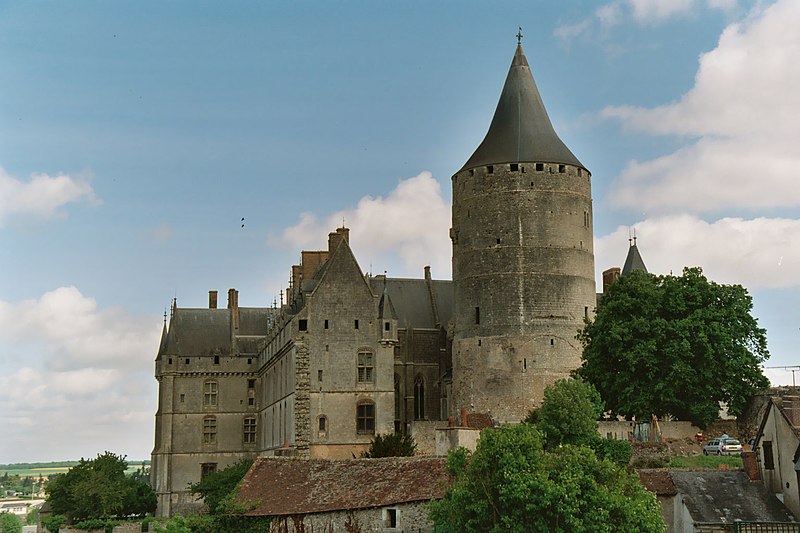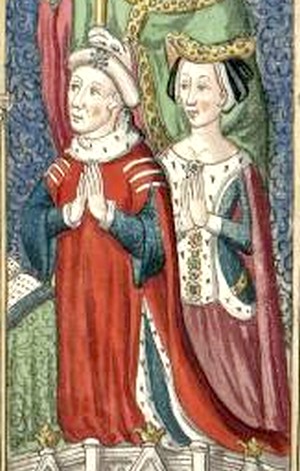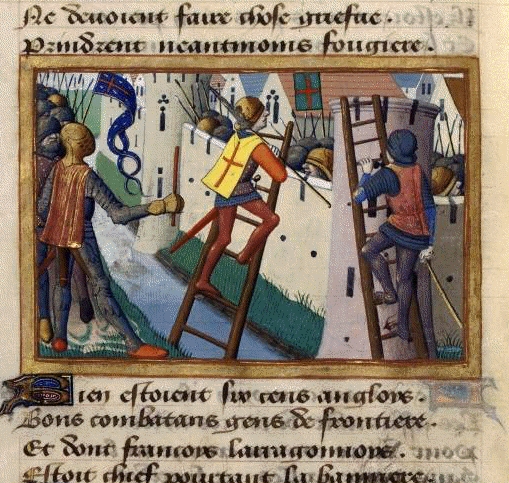 |
| Henry VI (L), Talbot (C), Margaret of Anjou (R) |
In the
summer of 1442 when John Talbot[i], the newly created Earl of
Shrewsbury, returned to France for the new campaigning season. He focussed on
the French enclave south of the Seine and in mid-July marched on Conches.
Dunois was
in charge of an army in the south which attacked Gallardon to draw off Talbot’s men. Talbot’s men took Conches before marching to
save Gallardon where Dunois’ presence and the sallies made by the French
garrison from Évreux put paid to Talbot’s plans.
Talbot then
turned his eye on Dieppe and took his army thence in November.
‘The erll of Shrewsbury layd
sege by water and lond to Depe; and kept it a whyle till he ferd so foule with
his men, that thei wolde no longer abyde with him; and so he whas fayne to high
away thense to Rooen.’[ii]
Dunois
followed and, with 1,000 men, took control of the defence of the town. The
dauphin Louis brought 1,500 men to relieve the siege. Faced with a relieving
force and a mutiny in his army Talbot retired to Rouen leaving a garrison overlooking the town where he remained ensconced. After relieving Dieppe
Dunois travelled to Brittany negotiate an alliance with the Duke and returned with Breton
soldiers for his army.
Brothers Reunited
 |
| Chateaudun |
Following
his release from his twenty five year long imprisonment in 1440, Charles
d’Orléans, as thanks for his services to the family, gave his half-brother the castle at Châteaudun.
January
1443 saw the death of La Hire from a chill picked up at the siege of La Réole during the exceptionally cold winter of
1442-3. The town surrendered in the autumn but the garrison in the chateau de
Quat’Sos stubbornly stuck it out and the cold was particularly trying for the
French soldiers in the trenches around the fortifications. In 1443 Dunois led the
French forces to the relief of Angers, being besieged by the English. And in that same year he was made Count of Longueville[iii].
 |
| Chateau de La Guerche |
In August
1443 Somerset returned to France with an army of 7,000 men. He landed in
Cherbourg and marched along the border between Maine and Brittany. Somerset
committed the cardinal error of attacking and taking the Breton town of La Guerche, part of the domain of England’s ally the
Duke of Brittany[iv].
Somerset then wandered aimlessly through Maine and when asked by his commanders
what his strategy was, replied;
‘I do not divulge my secret to anyone. If even my
own shirt knew my secret I would burn it.’[v]
According to the Bishop of Lisieux, Thomas Basin, who recorded Somerset’s utterance, it was doubtful if even
Somerset knew his own secret.
1444 saw the
release of John d’Angoulême and after his thirty-two year-long captivity John chose
to fight under his half-brother’s command.
The Come Back
 |
| Count of Vendome |
On 22nd
January 1445 Dunois, the Count of Vendôme, the archbishop of Vienne and the Duke of Bourbon were given
safe-conducts by the English to attend a peace conference with the Burgundians,
French and English, to be held near Compiègne. The conference happened in April in Vendôme[vi].
At the
conference a truce was agreed as well as a marriage between Henry VI and Margaret of Anjou, daughter of René of Anjou[vii]. The couple were betrothed on 22nd
May with an audience of much of the French nobility with the Earl of Suffolk[viii] acting as Henry’s proxy[ix]. Suffolk was accused of
making a secret treaty with the French, giving back Maine. He repudiated this claim in parliament he;
‘Nethir uttered ne communed
of the specialite of the matiers concernyng in any wyse the said Tretie of
peas, nor of what maner of thing the said Tretie shuld be, but only referred it
to oure said Soveraigne Lorde.’[x]
 |
| Le Mans |
By mid
to late 1447 the Duke of Somerset was negotiating with the French for the very
result that Suffolk had claimed he was not doing two years previous, the
handover of the county of Maine to the French. By 15th 1448 January
Charles troops were massing on the borders of Maine.
Despite
English promises that the handover would soon take place nothing happened and
the siege of Le Mans began in early March with the guns of the French
army battering the city walls. Dunois led the assault force of 6-7,000 men
which prompted the English to return to the peace talks. Le Mans was handed
over along with the rest of Maine on 15th March in a ceremony at the
gates of the city.
Reorganisation
 |
| Duke of Alencon |
Between
1445-8 Charles issued a series of ordinances reorganising his armies; the
remnants of the écorcheurs formed the
paid permanent basis of the army, formalising the use of the lance[xi] of which Charles had 1500, with
another 1500 from Languedoc and other lances known as petites ordanances[xii].
The
reorganised army was known as the Compagnies
d’Ordonnance. The companies captains were Dunois, Richemont, the Duke of Alençon and Poton de Xaintrailles. The
artillery train was revamped by Jean Bureau and Jacques Couer rebuilt royal finances at a time when the English were
repeatedly facing bankruptcy.
The dauphin
Louis was at loggerheads with his father who preferred to appoint men
recommended by René of Anjou. Charles d’Orléans and Dunois were joined with
Louis in resenting this dominance of the house of Anjou. The Milanese ambassador reported;
‘There are in the bosom of
the House of France bitter jealousies and red-hot factional strife. There could
not be more violent hostility than that which reigns between the illustrious
Lord Dauphin and the King of Sicily….[who] is the one who runs everything in
the realm.’[xiii]
 |
| Siege of Fougeres |
On 17th
July 1449 Dunois was made lieutenant general of Normandy; as lieutenant
general. Jean led many of the operations in the re-conquest of Normandy taking
Rouen, Verneuil, Mantes, Vernon, and other towns. Following the siege of Fougères, in July 1449 Charles VII declared war on the rump
state of England in France and four armies descended on Normandy. The town of
Verneuil[xiv] was recaptured by Dunois
on 19th July; he was now positioned to threaten England’s last
holdings in France, Normandy, from the south.
Talbot
marched to defend the town and Dunois counter-marched to meet him. Dunois
refused to attack the English who withdrew to Rouen, allowing an army under joint
command of Dunois and the Count of Eu to take Pont-Audemer. Dunois and Eu cut the town off from Rouen up river and
Harfleur down river. On 16th August Dunois took the town’s surrender
which included the subsidiary fortresses and protective strongholds around the
city.
Freeing Normandy
 |
| Chateau d'Harcourt |
In August
1449 the king himself joined Dunois and Eu outside Mantes from where he was able to negotiate
a series of bloodless surrenders as the commanders of the individual garrisons
lost faith in the promises of succour from England. Few places were defended
for more than a few days; the castle at Harcourt was defended for eight days and the fortress of Touques for three. Most surrendered within the day while some
strongholds were deserted when the French arrived.
In the
autumn of 1449 the château de la Roche Guyon surrendered after the Governor John Howell promised
to surrender if he was not relieved within fifteen days[xv].
The
Duke of Somerset was so enraged by these terms that he sent a team of 24 men to
murder Howell who was married to a French lady; Howell promptly switched sides
and surrendered the castle to Dunois.
 |
| Chateau de Gisors |
In mid-September
Coutances surrendered to the Duke of Brittany and his brother
Arthur de Richemont as they marched with an army of 7,000 men to meet up with
their allies. On 20th October the chateau of Gisors was surrendered by the governor Richard Merbury
whose son had been taken prisoner by the French at Pont-Audemer. As a reward
Charles made Merbury captain of St-Germain-en-Laye for life.
Bibliography
The Hundred
Years War – Alfred Burne, Folio Society 2005
The Reign of
Henry VI – RA Griffiths, Sutton Publishing Ltd 1998
The
Fifteenth Century – EF Jacob, Oxford University Press 1997
Louis XII –
Paul Murray Kendall, Sphere Books Ltd 1974
Margaret of
Anjou – Helen E Maurer, the Boydell Press 2003
John Talbot
and the War in France – AJ Pollard, Pen and Sword Military 2005
Philip the
Good – Richard Vaughan, Boydell Press 2014
www.wikipedia.en
[ii]
John Talbot - Pollard
[iv]
The town was returned to the duke
[v]
The Hundred Years War - Burne
[vi]
One of the delays was caused by Charles VII succumbing to an ailment
[vii]
Nominal King of Sicily
[viii]
He was created Duke three years later
[ix]
The wedding took place early the following year
[x]
The Reign of Henry VI - Griffiths
[xi]
Consisting of six mounted men, men-at-arms, one swordsman, two archers, one valet aux armes and a page
[xii]
Overall Charles had a standing army of about 15,000 men
[xiii] Louis XI - Kendall
[xv]
Fairly standard terms for a siege to save unnecessary deaths
No comments:
Post a Comment
Note: only a member of this blog may post a comment.